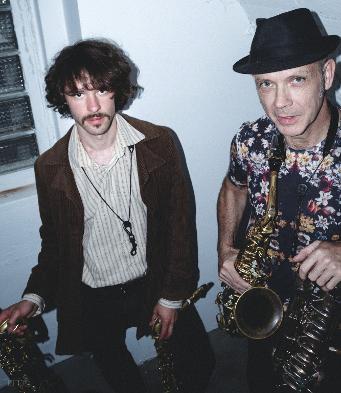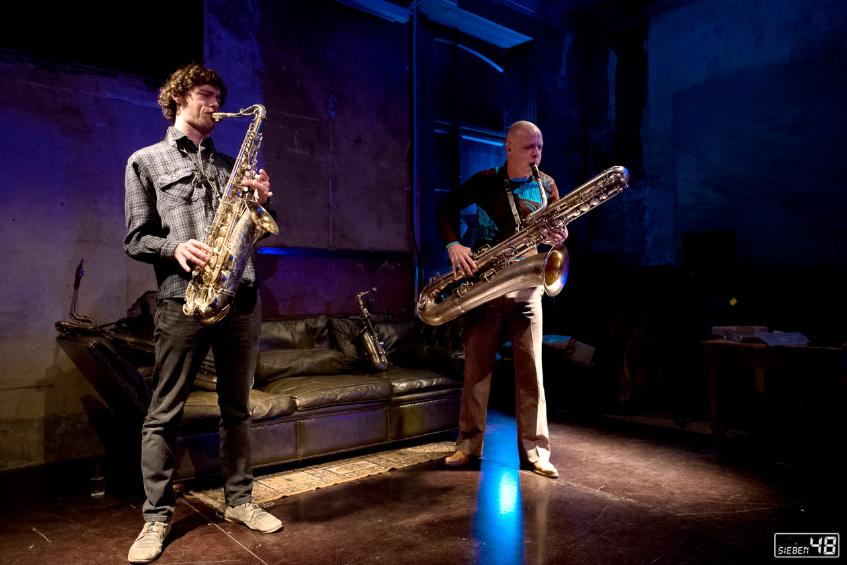
ABOUT ANGELS AND ANIMALS
JAN KLARE alto & bass saxophone
JULIUS GABRIEL tenor & baritone saxophone
It is somewhere in between, when Jan Klare and Julius Gabriel melt air-columns. They are both virtuoso saxophonists – driven by the urge of improvisation their music is about space, energy, communication and spirit. Somewhere between heaven and earth.
The duo of Jan Klare and Julius Gabriel is like no other. A brace of undulating ungulates, high flying heifers who paradoxically reside at the very core of the earth, they make beautiful music together on love-dancing altos or gargantuan bass saxophone beneath tenor or baritone. Germanic but far from manic, these two exhibit a patient, ego-free simpatico that offers joy to any sentient ear in the kingdoms of beast or firmament. (Michael Jackson)
Should a future Jazz historian be looking for a perception that would disassociate 21st Century improvised music from its 20th Century antecedent, communion has replaced challenge as an overriding musical motif. Like cars with giant fins, smoke-filled offices and steno pools, the idea of a cutting contest where one instrumentalist proved his skill by brutally defeating others in symbolic man-to-man combat is a relic of the past. Take these two-saxophone meetings for instance, Unlike the fabled Hawk vs. Prez or Jug vs Stitt reed battles, the players here are intent on advancing ingenious interaction while maintaining their own identities. The fashion of humiliated losers and triumphant winners is as outdated as spats. With the discs clearly slotted into the experimental expanse, each player works to expand the limits of his instrument to its utmost, For instance on the brief About Angels and Animals mini LP, with two Germans, veteran alto and bass saxophone Jan Klare, known for his leadership of The Dorf ensemble; and younger tenor and baritone saxophonist Julius Gabriel , who has played in Barry Guy’s Blue Shroud Band and the Dorf. Coming across most of time like a well-drilled unit – say half of Rova or the World Saxophone Quartet – the two use the tones from their saxophones to create notable contrasts in pitch, tempo and tone. By “Psilot” the result propels cyclonic timbres to wrap around one another like tendrils as flutter tongued extension multiply the tones. Imagine the meeting as air-inflated ring-around-the-rosie, here and on the other five tracks. Sometimes the duo work on a contrapuntal mirror of clear alto saxophone trills at one elevation and deeper pulls with oxen-like strength from the baritone as on “Iridop,” with the opposite strategy expressed on “Calamo”, as higher-pitched saxes bland like two halves of a bagpipe chanter, leading to gentling harmonies. Eventually the final tracks lead to a climax that confirms this polyphonic blending. Rumbles and squeals are melded into gorgeous harmonies which propel the themes forward, then satisfy the need for closure." (Ken Waxman, www.jazzword.com)
O nome de Julius Gabriel (saxofones tenor e barítono) já não é desconhecido do público português – faz parte de um novo grupo em que encontramos Gonçalo Almeida e Gustavo Costa, Ikizukuri, que ainda recentemente se apresentou no nosso país. No duo About Angels and Animals encontramo-lo na companhia do igualmente saxofonista (alto e baixo) Jan Klare, e se a música é tão intensa quanto a daquela banda de jazzcore (dizem eles próprios que situando-se «entre o céu e a terra», ou seja, misturando altas doses de energia com «uma profunda pesquisa espiritual»), os parâmetros são outros. Para nós, este vinílico “Fern”, para ouvir a 45 rotações, funciona como uma carta de apresentação: Gabriel e Klare estarão aí não tarda, para concertos a dois e com músicos nacionais. Tudo começa com sobreagudos dos saxes – fica anunciada a adesão à estética do grito inaugurada por um certo free jazz e pela livre-improvisação mais combativa. Mas logo depois instala-se o silêncio e o que vem a seguir é música exploratória, feita de intrincações sustentadas em combinações de timbre que nem por isso, e nem por recorrer a subtilezas e pormenores, é menos orgânica. Nova pausa, para uma entrada em pleno brutalismo. A chamada “arte bruta” tem uma correspondência musical e esta está aqui representada. Ainda assim, o presente disco tem enfoque não na violência sonora, mas numa perspectiva de distensão – o apaziguamento que vem a seguir à força animal, e cá estão uns “drones” anunciadores desse estado de paz. O desassossego volta mais adiante, claro, mas resolve-se sempre, e quando tal acontece assistimos a momentos de uma beleza próxima da dos anjos. (Rui Eduardo Paes, www.jazz.pt)

